Denial Ain't Just a River in Egypt, It's In Ethiopia Too
(Marie-mail #60)
DEJEN, ETHIOPIA
NOVEMBER 2
"Pen! Pen! Give me a pen!" Children waved frantically and chased our truck through town. We had just arrived in the small, dusty village of Dejen, an overnight stop en route to the Blue Nile Gorge at Bahir Dar.
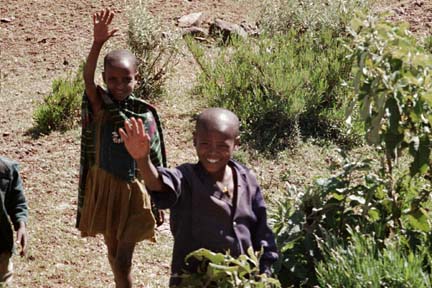
Our group was good at ignoring requests for pens by now, and drove straight to a hotel. My little blue tent had gone into semi-retirement now, as there were few campgrounds in Ethiopia. Hotels were so cheap we stayed in them on a regular basis, or just camped on hotel grounds.
Monica and I were sharing a room. We opened the shutters for a while, as the single lightbulb hanging from a ceiling cord emitted only faint light. But children excitably yelled in through the window so we closed it. Bathrooms were at either end, and the toilets flushed this time, through use of a plastic water bottle and a tub of water.
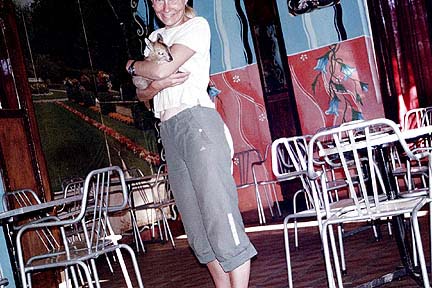 befriend your enemy
befriend your enemy
We cooked dinner on the truck, and then I managed to conquer my fear of chihuahua-sized antelopes by playing with the baby dik-dik that lived behind the hotel bar. As usual, Monica and I talked well into the night instead of getting much-needed sleep.
DEJEN TO BAHIR DAR
NOVEMBER 3
If Ethiopia had tourist hotspots, the city of Bahir Dar would be one of them, along with Axum and Gonder. Located at the source of the Blue Nile, it's the gateway to the Blue Nile Falls and the 15th-century island monasteries on Lake Tana.
 defunct tank under a bridge
defunct tank under a bridge
After arriving in late afternoon, we set up camp on the grounds of a hotel. Monica and I did our part for the local economy by getting a twin room for 105 birr (thirteen dollars), complete with hot water and a verandah by Lake Tana.
We had dinner by the truck, and then Claudine, Monica, and I teased Trigger.
I've forgotten what we were teasing him about. Probably about his tendency to attract young female tourists from other trucks. Claudine, Monica, and I were tough to argue with when we teamed up, and his only defense was to get physical.
Trigger rugby-tackled me and left me panting on the grass. I laughed and raised my head...
...just as he tackled Claudine. Her right foot, ensconced in a heavy hiking boot, bashed me in the eye.
 ping-pong is popular in Bahir Dar
ping-pong is popular in Bahir Dar
I saw stars and sat down. Trigger felt terrible, Claudine felt terrible, and I felt worse than both of them.
"Let's see," said someone. I showed my eye. It had reddened and been scraped up.
"That's gonna be a shiner," said the same person. I was going to have a black eye to go to Sudan with. Claudine and Monica got some ice from the hotel restaurant, Nathalie loaned me a face cloth to put it in, and I put it over my eye and went back to my room to sulk.
"That'll teach me to be social," I laughed when Monica came in a minute later. I had been better off when I was miserable and alienated.
BAHIR DAR
NOVEMBER 4
My alarm went off. Monica ordered me to sit up.
"Let's see that eye," she said.
"That could be a lot worse."
I forced my aching bones out of bed and went to the bathroom mirror. I had a faint bruise on my eye, but most of the damage had turned into scabs over reddish scrapes. With any luck, it would have faded by the time I was trying to look non-descript in a headscarf in Sudan.
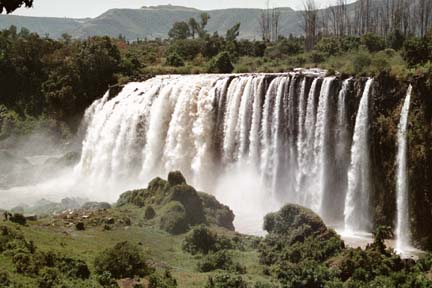 Blue Nile Falls
Blue Nile Falls
Our group excursion was to the Blue Nile Falls, called Tisissat in Ethiopia. It was a 30 kilometer drive, so the trip there and back, coupled with the hike to the falls, was a half-day, pleasant-enough affair.
In the afternoon, I went around town to hunt for internet access. There was plenty, but the electricity was off throughout Bahir Dar.
A young boy approached me on the street.
"Are you with Dragoman?" he asked. "Do you know Kaunda?"
"No," I told him. "Do you mean Kaunda that cook?" Kaunda had been the cook for the group for the pre-Nairobi route that I had done solo.
"Yes, Kaunda the cook. Do you know if he is still alive?"
It turned out that the kid had heard about a tourist truck accident on the radio. He was concerned that it might have been a Dragoman truck and that his friend Kaunda might have been in it. I assured him that it was not a Dragoman truck and that Kaunda was very much alive. He gave me a note to pass on, which I later gave to Mark who put it in a DHL package back to the UK, where it would be sent in a package to Kenya.
I ended up using the internet at the hotel later, where it was cheapest, and as a plus, there was power.
NOVEMBER 5
Morning brought a motorboat trip to two Lake Tana monasteries and the source of the Blue Nile.
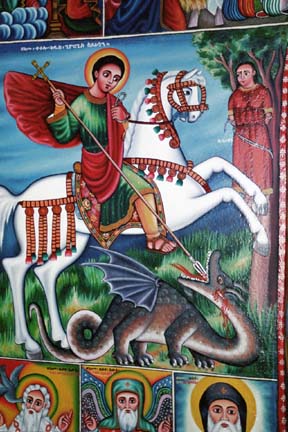 St. George is popular in Ethiopia
St. George is popular in Ethiopia
Ethiopian Christianity is Orthodox, full of undiluted and unique traditions. Much of it is straight out of the Old Testament.
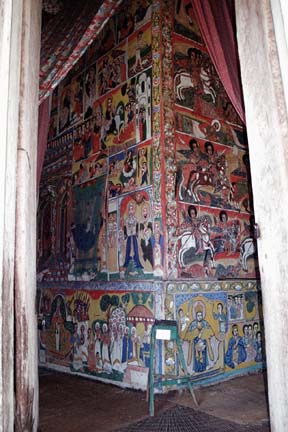 ancient monastery
ancient monastery
Just as the official language of the Vatican is Latin and only priests and scholars know it, Ethiopian Christianity uses the dead language of Ge'ez. No one can understand it, so perhaps that is why colorful, sequential art adorns the walls of churches, telling the stories of the Ethiopian Bible through the universal language of bright, appealing comic strip art.
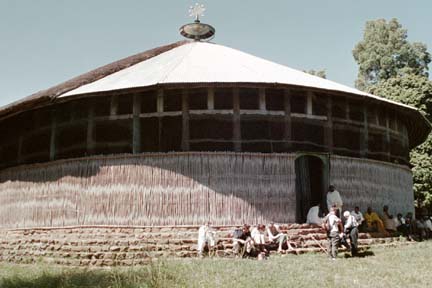 exterior of monastery
exterior of monastery
The "monasteries" were all round buildings with thatched roofs. Inside, the walls within the walls were decorated with murals of St. George, the adventures of the Virgin Mary, and one in which Mary was punishing baby Jesus for being mischievous. Inside the inner walls was a holy sanctuary. We were not allowed access, as only the holiest can go there to approach each church's most valued possession -- its tabot, or replica of a tablet of the Ark of the Covenant.
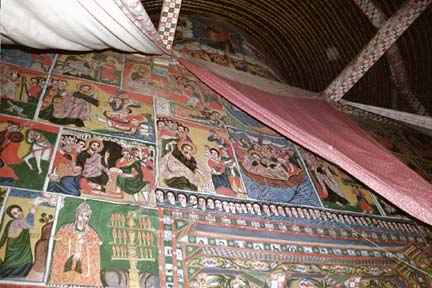 walls are covered in comic-book style frescoes
walls are covered in comic-book style frescoes
The real Ark, the superpowered chest that purportedly holds the tablets inscribed with the Ten Commandments, is not actually stored in a crate in a massive government warehouse (as reported in "Raiders of the Lost Ark.") Instead, according to Ethiopians, it was brought south during the time of King Solomon, and after a long epic journey of hundreds of years, found its way to Axum and St. Mary of Zion's Church, where it resides in seclusion today. Researchers have found nothing to support this claim, but they have found nothing to deny it either. Graham Hancock, in his book "The Sign and the Seal," provided evidence that the claim is, at least, not preposterous.
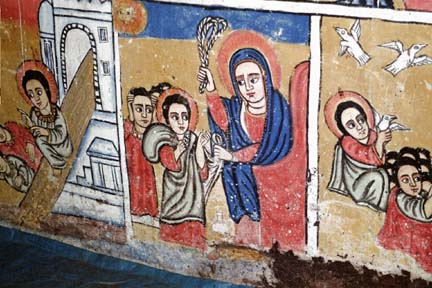 even baby Jesus sometimes needed discipline
even baby Jesus sometimes needed discipline
Our second scheduled monastery visit was to a men-only monastery. Apparently a powerful Jewish warrior queen, Queen Judit, once razed the monasteries of Lake Tana, and no females have been allowed to the holiest places since then . Even female animals were kept away.
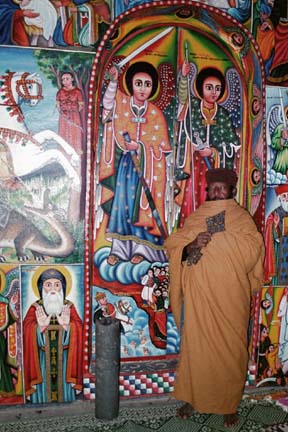
Us women sniffed and visited a newer monastery, where a cross-eyed priest welcomed us and fed us some dry bread cooked by a local woman. We secretly knew we'd gotten the better end of the deal, but tried not to rub it in when the guys returned.
 women-friendly monk
women-friendly monk
Next was a quick boat trip to the source of the Blue Nile. Seasick Monica unceremoniously barfed into it, thereby assuring her own minuscule but amusing dissipated impact on Sudan and Egypt.
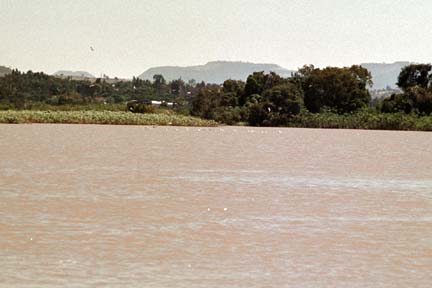 source of the Blue Nile
source of the Blue Nile
Later, back at the hotel, a pickup truck delivered us a new tire to replace one that had been worn out by the volcanic rock back in Kalacha. The pickup couldn't start when it was time to leave, so I joined a group of men in push-starting it.
"Need a ride?" asked the driver after the truck started.
"Sure!" I called Monica over and we jumped into the back of the truck, to go off to town and hunt for goatskin lunchboxes.
The lunchboxes were not really boxes. They were round and covered in goatskin, like furry, overgrown coconuts with the tops lopped off. The tops were then put back into place, and held there with goat-leather straps. Injera and spicy tibs or pureed vegetables usually were stored within. They were a specialty of the region, and in spite of having no need for a goatskin lunchbox, I knew I had to have one.
A group of young men from the pickup truck accompanied us. They acted as our de facto guides, as we couldn't seem to get rid of them and I opted to make the best of the situation by cheerfully asking them as many questions as I could think of. I didn't know if they were able to get a service charge from merchants we shopped from or if they just expected to get something from us. Later, one asked for a pen. I didn't have a spare.
I was not in Ethiopia to teach anyone a lesson. Surely, "you won't get a pen from attaching yourself to tourists" was a lesson well worth learning, but what of the poverty, and my personal guilt? What was my responsibility? Was it to provide free creature comforts or to force some unrequested self-respect onto those who assumed the role of beggar?
The westerner should not, I believe, encourage the perception that they are Santa Claus by handing out little trinkets. It really only aids the ego of the giver. But one cannot ignore poverty, especially in light of the West's complicity in taking advantage of the resources and instability of undeveloped regions in order to pass on greater consumer advantages back home. I could get a pound of high-grade coffee beans in New York for less than six dollars, but African coffee farmers were starving.
Philip Briggs, in his Spectrum Guide to Ethiopia , provided me with no answers, but at least contextualized my confusion and guilt.
"We should expect to experience some level of guilt at confronting the realities of a country like Ethiopia - it would take an overdeveloped sense of self-righteousness not to - and accept that this guilt will influence our thoughts and actions. In this light, it is best we consciously confront the question of guilt and decide to what degree and in what manner we should respond to it."
 rural Ethiopians
rural Ethiopians
He goes on to say that the best response to this guilt is to patronize local businesses and hotels. I have been convinced by my travels that the economic "fair trade" solution is the best and only long-term solution.
"Your presence in a country like Ethiopia in no way exacerbates any local suffering. On the contrary, Ethiopia, like most developing countries, is desperate to encourage tourism because it brings in foreign revenue and creates business opportunities and jobs. If you want to do something for a country like Ethiopia, spending your money there is asserting your consumer power in the most positive manner possible. It strikes me as a far more appropriate response than to travel only in developed countries and pretend the inequality doesn't exist."
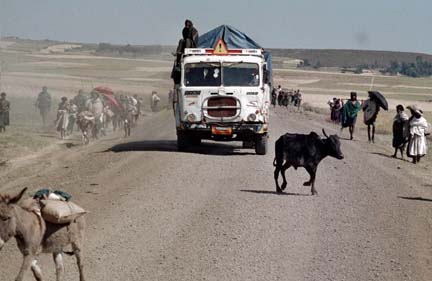 on the road
on the road
I gave the kid some birr and thanked him for his assistance.
BAHIR DAR TO GONDER
NOVEMBER 6
Our morning drive took us to the next hotspot on the Ethiopia tourist circuit. Gonder, with its 17th-century medieval castles, is the Ethiopian Camelot.
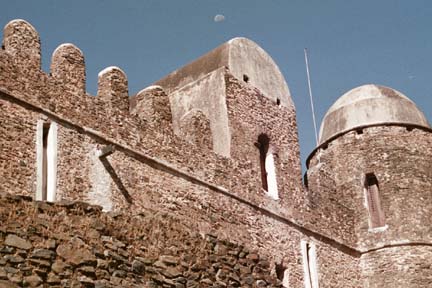 castle in Gonder
castle in Gonder
It is also the jumping off point for transit to Sudan, so I would be returning in just over a week. I ran around and gathered information on transport and accommodation, and checked my e-mail to discover to my great pleasure that I could catch a Grimaldi freighter to Italy from Egypt, on November 21.
Satisfied that the last variable in Marie's World Tour was no longer in question, I toured the town and looked for a place to stay when I returned. The little blue tent (along with my Thermarest) and I would be parting ways when I left the Dragoman truck. I couldn't carry everything on my back.

Two young men, Peter and Ababa, introduced themselves. They were part of the horde of Mark-idolizers, the dozens of Ethiopians who turned out to greet Mark every time he came to town. He was an icon in Ethiopian tourism, which extended to his passengers and meant that we were often elevated to a level of great respect simply by affiliation.
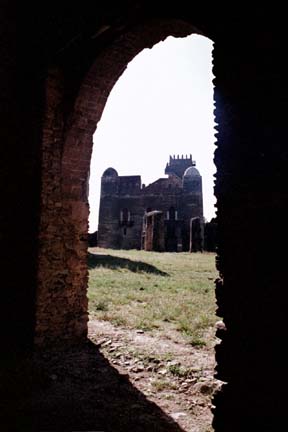
"What are you going to do today?" asked Peter.
"I don't know," I said. "Maybe to check schedules at the bus station. Maybe I'll go to the pottery shop."
"You can go to the Falasha village to buy pottery there if you want."
I said sure, but I didn't want to pay a lot for a taxi. I was interested in Falasha Jews, after having read about them. Peter stayed behind with me while Ababa went and negotiated a horse-drawn carriage for us. Supposedly, they got a better rate because they could negotiate without me in the way.
Ababa had to run alongside the cart until we were out of the city limits, because no more than three are allowed to ride in the horse-drawn carriage. And I had never seen such a thin, miserable horse. But I saw plenty more of them over the next ten days.
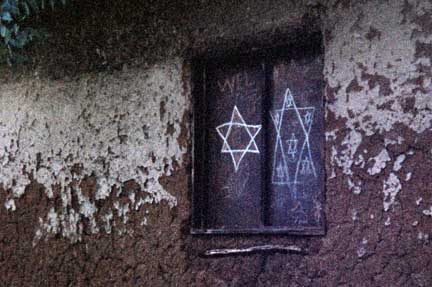 Welcome to the Falasha village
Welcome to the Falasha village
The Falasha village turned out to have exactly ONE full-blooded Falasha Jew left, and she was looking for a sponsor to take her to Israel. There were enough mixed-non-Falasha Ethiopian Jews, enough to keep a mud hut-synagogue in business.
 center, the last Falasha Jew in Gonder
center, the last Falasha Jew in Gonder
"Shalom," I said to the last Falasha Jew in Gonder. She sold me a piece of pottery, a black clamshell piece that opened up to show the Queen of Sheba and King Solomon in bed together. According to the Ethiopian Bible, the Queen of Sheba was Ethiopian (somebody else must've believed this too as they sculpted her onto a porch at Chartres Cathedral in France, complete with her "Ethiopian slave").
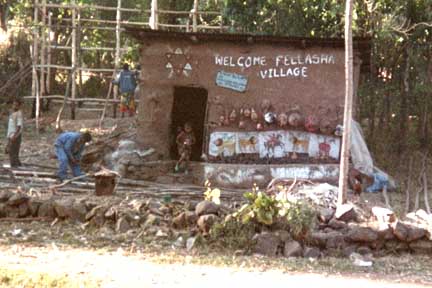 mud synagogue
mud synagogue
The Queen of Sheba had supposedly traveled to Jerusalem, where she had conceived a son (Menelik) with King Solomon. Later, the son returned to Jerusalem to take the Ark of the Covenant home to Ethiopia. Most researchers have called this poppycock, suggesting that the timeline is off, but that the Ark could have come to Ethiopia at a different time by traveling down the Nile.
On the buggy ride back to town, I asked Peter and Ababa why everyone wanted pens. They told me the pens were for schoolwork.
"But what about if tourists give then pens to teachers, and they can distribute them, so that the kids don't have to beg the tourists?" I asked.
"Then the teachers keep the pens," replied Peter with finality.
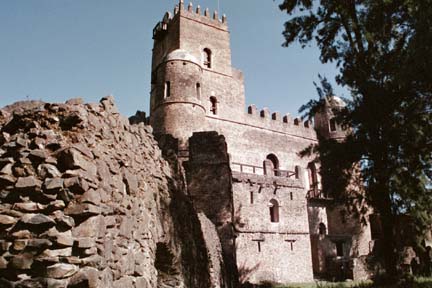
They saw me back to the hotel, and asked me to send a Bob Marley cassette when I could.
NOVEMBER 7
We had set up our tents in the garden of an old Italian hotel, and the sound of birds was marred by not-so-distant crowds, engines, and distorted Ethiopian pop. The water in the hotel bathrooms was freezing, so we had mostly opted to stay dirty.
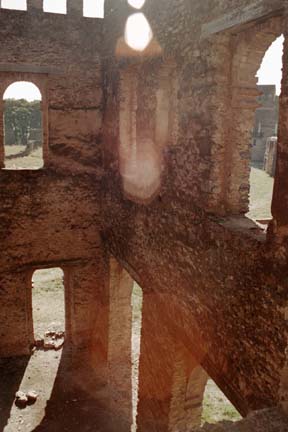
Our morning excursion took us to the Royal Enclosure, Fasilada's Bath, and Debre Berhan Selassie Church.
Emperor Fasilada was the man credited with building most of the palaces and baths in Gonder, but excavations have indicated that various emperors built the castles over two centuries. Wars, invasions, and time have destroyed a lot of buildings, but some stand dramatically within the Royal Enclosure, a 76,000 square meter compound of castles, stables, churches and towers. Fasilada's Bath is a small castle built within a compound that features a square lake that is filled once a year for Ethiopia's main Christian celebration.
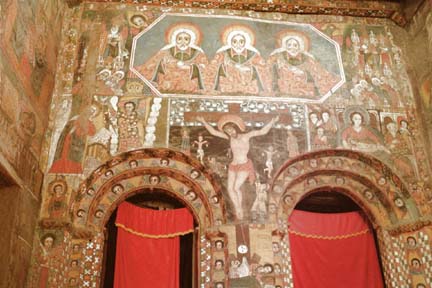 Debre Berhan Selassie Church
Debre Berhan Selassie Church
Debre Berhan Selassie Church was built by the grandson of Fasilada, and contains the most visited famous frescoes in Ethiopia. We stopped by to admire the colorful religious murals, including the individually unique angel faces on the ceiling, but all felt a bit crass as we had to tiptoe around a funeral to get to the tourist attraction.
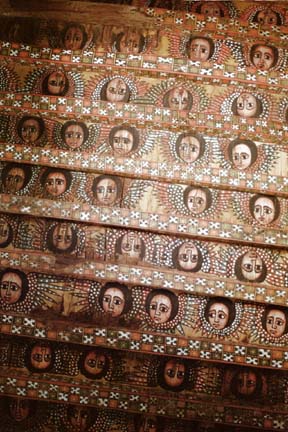 angel frescoes on ceiling
angel frescoes on ceiling
I ditched the group and headed to the bank -- they were going to the Falasha Village I'd been to yesterday. When I walked back to the hotel, I was accosted by three little girls. Mary, Marta, and Hannah were determined to do my hair, and by the time I had escaped their clutches I had some ridiculous braids piled up on my head. I took them down later, but then had to duck down inside the van when we left the hotel compound so they wouldn't see the damage I'd wrought to their handiwork.
 priest preparing for the sun
priest preparing for the sun
We spent the evening admiring the clean, flushing toilets at the posh Goha Hotel. Concurrently, we admire the view of the town and ate some nice roast beef.
NOVEMBER 8
GONDER TO DEBARK
"V. scenic drive" read today's itinerary. Monica and I giggled over this, wondering why Mark couldn't be bothered to write out the word "very." Our destination was a bush camp between Debark and Axum. Debark itself was the gateway town to the Simien Mountains, but didn't have much in the way of hotels. The "best" one was full, so we were aiming for a makeshift campsite up the road.
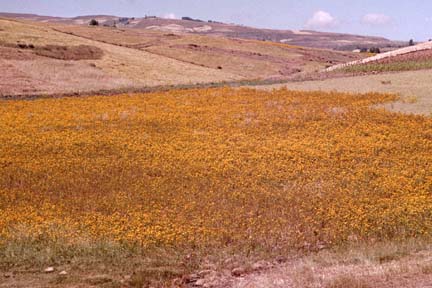 very scenic drive
very scenic drive
I finished up "The Sign and the Seal" just in time, as its climax took place in Axum. Graham Hancock noted that the Falasha Jews he'd met were "a degraded and impoverished peasant culture overanxious to pander to the enthusiasm of foreigners." I could say the same for a lot of places I'd visited this year, and while I wouldn't apply this description to Ethiopia, I would to some of the tourist-track towns in Kenya and Tanzania. I now understood what people meant when they described a place as "ruined by the impact of tourism." He also cited a historical basis for the comparison of Ethiopia to India. Supposedly an old edition of the Encyclopedia Britannica noted that comparisons between Ethiopia and India dated back to Virgil and before. The two were somewhat similar. Both had a great deal of poverty and seeming chaos. What this translated to for a tourist was a lot of panhandlers and "gimme" people, that turns off most travelers but encompasses a rewarding, complex culture underneath for those who are determined to penetrate the outer defenses.
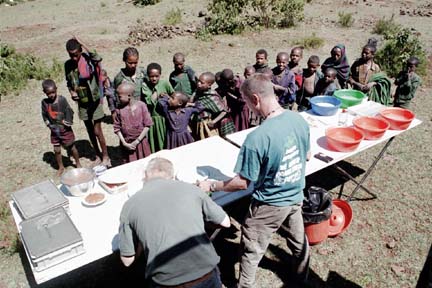 dinner by the truck always gets an audience
dinner by the truck always gets an audience
We set up camp in some foothills. I parked my tent far away from the others, under a tree where I could listen to crickets and birds. I lit a candle and read outside my tent, in a bubble of light amidst the total darkness.
NOVEMBER 9
DEBARK TO AXUM
Unfamiliar voices were chattering in low tones outside my tent. I took my time emerging. It would be local people, their curiosity bringing them out to stare at the freak show on wheels.
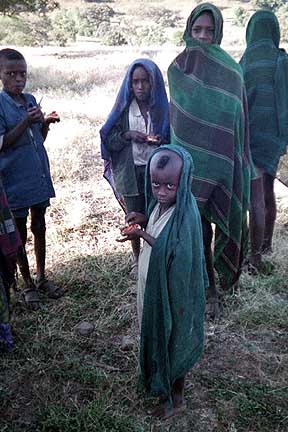 the audience for morning ablutions
the audience for morning ablutions
When I did emerge, eight pairs of eyes immediately swung over to rest on me. The eyes' owners were all dressed in tatters, but that didn't mean anyone was here to beg. They were only watching. Later, when we offered our breakfast leftovers, the locals refused them until we pointed out that the beans on toast were vegetarian. It was, after all, one of Ethiopia's Orthodox Christian fasting days that come around twice a week.
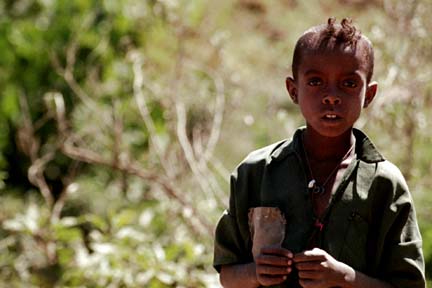 handle or tuft?
handle or tuft?
I packed up my little blue tent with sorrow. I would not be using it again, and was giving it to Monica for her continuing Dragoman trip that would end in Nepal in February. It had provided me with the illusion of privacy and control, and had been a haven of sanity in an unrelenting group situation.
We continued on with our experience of floating through Ethiopia in a tourist bubble. It wasn't altogether unlike watching Ethiopia on TV, with the soundtrack blaring "youyouyou" all the time. Our drive took us through minuscule towns of mud huts and boys in donated DARE t-shirts and rags. The smaller boys' hair was all shaved but for tufts just above the foreheads. Our local Ethiopian guide said this was so that if they were to die, they could be lifted by God by their tuft-handle hair.
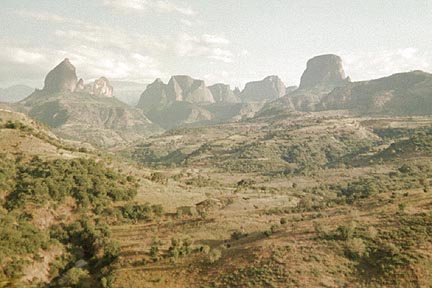
We hit Axum just before lunch. It was larger than a town, but not quite a city. As usual, the only proper building was the one housing the "Commercial Bank of Ethiopia," with its big Western Union sign. Aside from this, Axum seemed composed of hollow cement blocks with tin roofs. We checked into the Axum Touring Hotel, where I showed Monica how to put up the little blue tent and then handed it off to her. My Thermarest went to Mark to be passed on to a man who was trying to start up a camping supply rental business in the Simien Mountains.
 Sam the Dragoman cook
Sam the Dragoman cook
Dinner was Sam's ultra-spicy beef curry, followed by a trip to the bar to discuss the socially relevant topic of "what would happen if the Teletubbies went over to the Dark Side."
 the Dragoman group
the Dragoman group
NOVEMBER 10
Our local guide, Tesfaye, proudly told us that he had been the Axum guide in "The Sign and the Seal." After he left, I presented Mark with a paragraph in which the author had described the guide Tesfaye as spending "all his time in a brothel." Unfortunately, Tesfaye had a prior engagement and was not able to guide us through the sights of Axum, and I could not ask him to autograph the paragraph in question.
 our fearless leaders Sam, Tony, and Mark
our fearless leaders Sam, Tony, and Mark
We took the truck to the Archeological Museum, to look at artifacts from Axum's ancient past. It was and is the holiest city in Ethiopia, and was the capital thousands of years ago. Christianity was declared the Ethiopian national religion in Axum in the fourth century, and the Ark of the Covenant theoretically resides in St. Mary of Zion Church just down the street from the museum. Only one monk is allowed access.
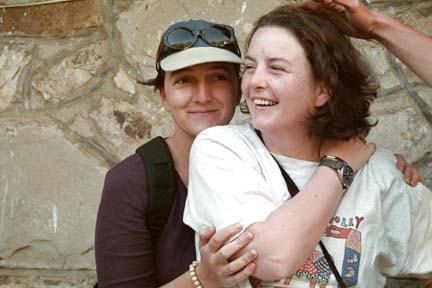 Francesca and Monica
Francesca and Monica
We walked to the nearby stelae field, accompanied by anxious teenage boys trying to sell us crosses. One of them wore a t-shirt advertising a plumbing company on East 18th Street in Manhattan.
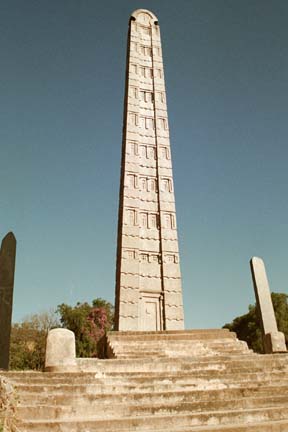 ancient Axum stelae
ancient Axum stelae
Stelae look an awful lot like obelisks. In fact, I am not altogether sure what the difference between the two are. They are both granite pillars that end in a point, and have carvings on the sides. Only five percent of the stelae site has been excavated and archeologists have hundreds of years of work ahead of them in Axum.
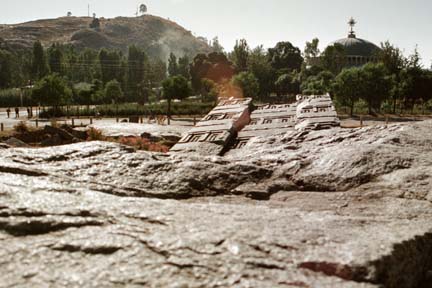 St. Mary's, where the Ark of the Covenant is kept
St. Mary's, where the Ark of the Covenant is kept
The tallest standing Axum stelae is seventy feet high, while the collapsed one directly across from St. Mary's is 110 feet of fallen glory. Some believe that the power of the Ark was used to raise the stelae, and to win "unwinnable" wars.
Next, we saw some underground tombs, where Sam tried to sell a kid a rock. The kid had been dogging our footsteps to sell us a gemstone, and Sam was tired of it. The kid looked confused.
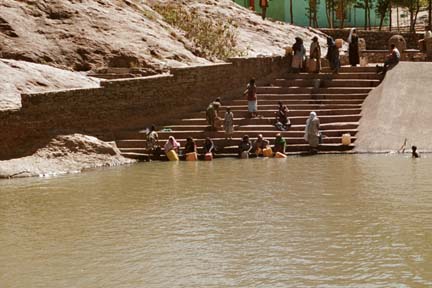 "Queen of Sheba's" bath
"Queen of Sheba's" bath
The rest of the day was spent at the Queen of Sheba's bath and the Queen of Sheba's palace. It was a hard to get excited about it though, as the Queen of Sheba probably existed much earlier than the ruins were dated.
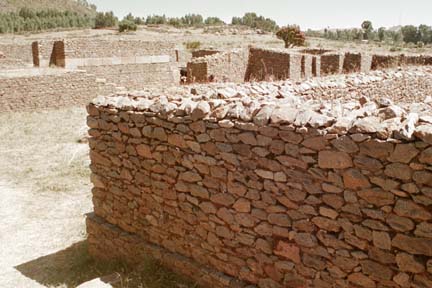 "Queen of Sheba's" palace
"Queen of Sheba's" palace
I took off alone into town to acquire an Ethiopian headscarf for my solo excursion into Sudan, and every shop I went into tried to get me to take tea. I felt guilty fleeing, but I needed to get to the bus station to buy tickets. Monica and I were leaving the truck for the loop to Lalibela in the morning. Monica would rejoin the Dragoman trip in five days, to return to Addis and then fly to Cairo.
 Trigger and Sam model the food of the gods
Trigger and Sam model the food of the gods
After dinner, I sat alone in the hotel room. Everyone else went to a disco, so when I came back outside later, only Tony and Mark were around. Mark had lost his room keys and was depressed about it. Tony went to sleep and Mark and I sat alone while he obsessed over his missing keys. My Dragoman trip ended on an anticlimactic note, with him being distracted and everyone else missing.
 the Dragoman group
the Dragoman group
NEXT: Marie and Monica strike out alone to Mekele, Woldia and Lalibela, and find out the "point of departure" for a massively-overloaded Isuzu cargo truck with no headlights on a bad road in the middle of the night.